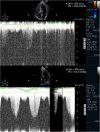Clinical applications of exercise stress echocardiography in the treadmill with upright evaluation during and after exercise
- PMID: 23875614
- PMCID: PMC3723430
- DOI: 10.1186/1476-7120-11-26
Clinical applications of exercise stress echocardiography in the treadmill with upright evaluation during and after exercise
Abstract
Exercise stress echocardiography is the most frequently used stress test in our laboratory. Exercise echocardiography is used mainly in the study of patients with coronary artery disease. However, the technique is increasingly being used to study other diseases. In our centre, we use an original methodology, published by us in 2000, in which we evaluate heart function during exercise in the treadmill. After the exercise, patients are maintained in orthostatic position when appropriate or lying down in left lateral decubitus for further evaluation. Since this method seems to increase the quality and the quantity of information obtained in so many clinical arenas, we now present a detailed review of this methodology and its applications.
Figures














References
-
- Roger VL, Pellika PA, Oh JK, Miller FA, Sewward JB, Tajik AJ. Stress echocardiography. Part I. Exercise echocardiography: techniques, implementation, clinical applications, and correlations. Mayo Clin Proc. 1995;70:5–15. - PubMed
MeSH terms
LinkOut - more resources
Full Text Sources
Other Literature Sources
Medical

